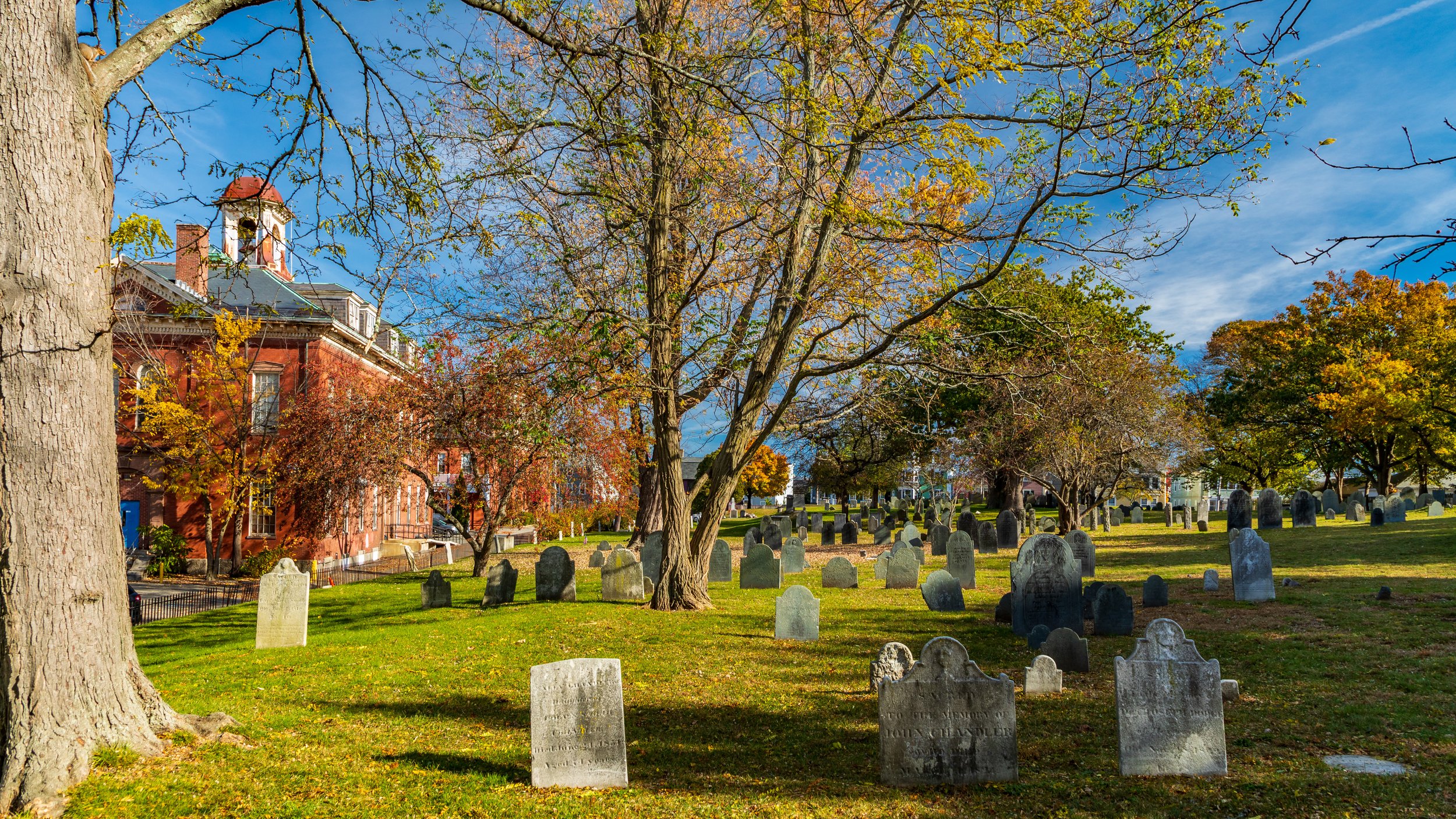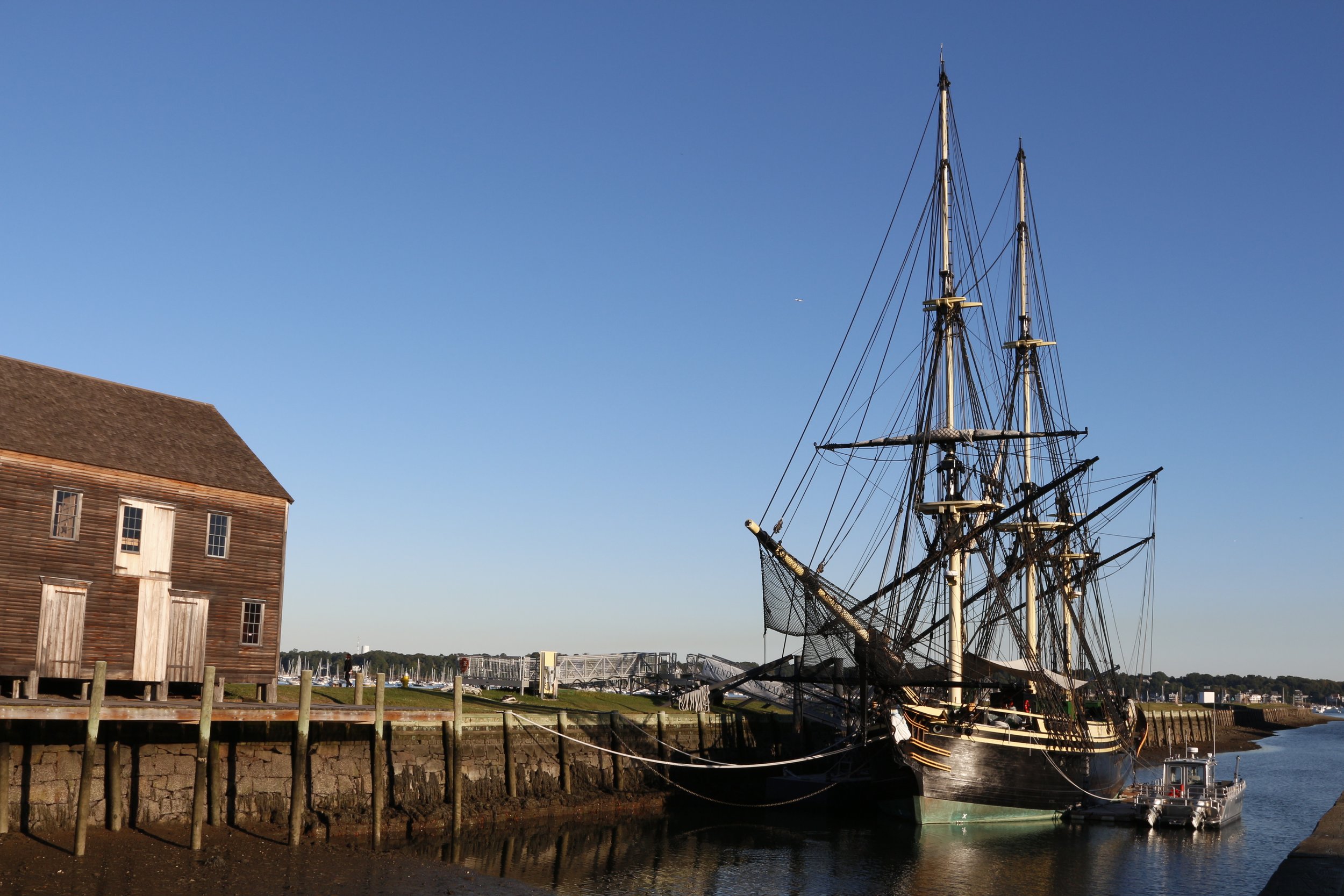Howard Street Cemetery
Branch Street Cemetery
Salem, Massachusetts
In any season Salem is a spellbinding town but especially in the fall. It is hard when you discuss cemeteries to not find yourself back in the Witch City. Its grounds filled with tales and curses that intrigue millions of visitors each year with the promise of hauntings. We opened Charter Street on our last visit to Salem and rightfully are returning to open its other notorious burial ground Howard Street. In the debate of what's Salem's most haunted cemetery Howard Street is highly considered to top Charter Street for many. It is not as old but for its residents they are aptly making up for lost time. Howard Street was originally known in the witch city as Branch Street cemetery next to the old Salem Jail downtown. It was established in 1801 and had its last burial in 1953. The cemetery sits on 2 1/2 acres (about the area of a Manhattan city block) with 1,100 headstones and unknown number of souls within. Many who call Howard St their home were local ship captains' soldiers from the revolutionary war or prominent members of Salem's African American community. A portion of the cemetery was dedicated to African Americans in 1800's which was common occurrence of the time. Much of Salem's known history is thrown into its witch trial years that sadly miss upon its other contribution. Inside Howard Street 5 Revolutionary War soldiers and 17 sea captain's graves can be found make it an intriguing visit into history beyond the witch trials. Resident Col. Samuel Carlton who fought in revolutionary war is the highest-ranking war hero. Carlton raised a regiment in Salem then marched to Fort Ticonderoga. He fought under Washington at Valley Forge is laid to rest within with his wife Eunice. Other soldiers from the Revolutionary War are Captain Henry Tibbetts, William Prossor, Stephen Wood, Lieutenant Charles Richardson, Captain John Collins, and Jonathan Archer III.
The first headstone is believed to have been placed in Aug of 1801 for second mate Benjamin Ropes. Ropes had a tragic and painful death being crushed to death while launching the foretopmast on the ship Belisarius. This was the start of suspicions of a curse placed on the burial ground from a man who've we have mentioned before on The Grim but more on that later. To add intrigue to the curse many within seemed to have suffered similar fates. 10 residents alone are from the old Salem jail after the floor collapsed and they too were crushed to death. Dead by crushing is held by an astounding 15 percent of those laid to rest within. As Howard Street grew in the years it became a burial ground for members of well-known families in Salem and for many immigrates from Ireland too. The names still eligible on headstones in the grounds feature many Irish names. Of the sea captain’s buried in Howard St. You can find Captain William Browne who perished in 1802. Brown's tale is a tragic one and sounds much like a bedtime story but with a grim fate. Entrusted with Brutus a ship that belonged to a high-profile firm Crowninshield in Salem Captain Browne set off to carry cargo of coffee and pepper in a chilly February with two other ships. Just one night into their voyage the three ships found themselves in the middle of a bitter snowstorm off the coast of Cape Cod. The fierceness of the snowstorm, with blinding snow, icy winds and harsh waters battered the ship Brutus and it began to break apart. Captain Browne along with his crew were forced to abandon the ship with only one crew member unable to search the shore new Providence Town on Cape Cod. Yet things only went worse on land for the crew, the freezing temperatures in New England bitter for any February taking the lives of the sailors one by one. The first was Browne with his second mate then also perishing then more following. Despite traveling with two other ships the snowstorm made it impossible for the other crews to know of the Brutus fate leaving them alone. The crew however soon realized they were close to a nearby Light House and with the helper of the Light Housekeeper were able to bring the remaining survivors to safety. The captain along with 11 other members of his crew met their grim fate that evening but 15 lucky few survived to tell the tale. A majority of those who passed were buried in Truro a small village in Cape Cod. The captain's remains however returned to Salem If the story was not tragic enough Captain Browne was also set to marriage a young woman named Priscilla Webb when the tragedy occurred. Miss Webb after losing her beloved Captain remained unwed for the rest of her life devoted to his memory and a testament to her undying love for him. His headstone on his gravesite is engraved with an urn and willow near the top with the story of his voyage below. The Brutus's tale is a huge reminder that Salem although a town full of tales of witches was also a huge contribution and still is in the maritime community. Not long after being established Howard Street Chapel was constructed in 1805 but this oddly was not the reason for its name change in 1828. Honoring local sailmaker John Howard, Salem renamed Branch Street to Howard and thus also the cemeteries name as well. Then in 1871, the Howard Street Church became the Prescott School removing any doubts of being a graveyard and not a cemetery. Salem's maritime connections can be seen in Howard Street with many sea captains laid to rest. Capt. George Crowninshield, Jr, a Salem merchant who died 1817 grave can be found within. Many of the grave's inscriptions are weathered and lost to time making it feel like the residents are unknown and want to be. One unmarked grave within however lacking a headstone for whom never know rest is Giles Corey. Buried before Howard Street's establishment Corey was one of the infamous witches of the Salem Witch Trials. Prior to 1801 the cemetery was just a large open field in Salem that was used for Giles infamous sentence of being pressed to death. Unlike the other accused Corey was a man and an honorable one of in the community when he was accused of witchcraft. Yet Corey's life throughout his years were filled with sorted tales and reason behind being accused. One of the fun aspects of researching and digging up history about graveyards is some the details you learn about its residents that most history books or quick google searches miss. Corey was one of those tidbits I personally found remarkably interesting. He was not a woman, he was thought as an honorable man and lived on a farm outside of town. Making him an odd choice for witchcraft so it seemed to me in the beginning. I could not have been more wrong after doing lot more researching though. There are many books about the Salem Witch trials, documentaries and articles floating around on the web. One novel Witchcraft in Salem Village in 1692 by Winfield S. Nevins was one of the driest and best accounts of the trials I have read so far. It was written in 1892 so still far removed from the original events but filled with many details most leave out. Corey in Nevin's novel was not an honorable respected man as first perceived but a grumpy curmudgeon most of Salem seemed to have a bitter encounter with. His first wife and son passed away from a fire leaving Giles a lonely farmer. He became known in town as a mean drunkard beating on of his farm hands so violently that three days later the man passed away. Giles was prosecuted for his death but in the end only fined which must have bothered a puritan village.
He then remarried to Martha his third wife an honorable and beloved woman in the community that changed Corey's reputation. He joined the community church and seemed to be finally finding his better or kinder years later in life. What I found most interesting about Nevin's book was all the accused had a run in with the prominent members of the town families of each of the victims. Corey was no exception having a run in with John Proctor in 1678 being accused of setting Proctor's house on fire but was acquitted. He then boldly countersued Proctor's accusation and won making the feelings between them understandably bitter. It is also important to note Salem was still a small town and Putnam was also involved in the court being a lawyer. It being noted that although these events before Ann Putnam's time. She would have heard them from her father retelling Corey's tale making it more likely as to why he and his wife Martha both were accused of being in league with the devil and executed. Of all the accused and executed Corey was the only one pressed to death in the Salem Witch Trials. This was because of his refusal to be sentence by the Court of Oyer and Terminer. Back in the day the English Law stated that those "standing mute" and who refused sentencing were charged with penalty of pain fortdure. Being thought to be undoubtedly guilty of the sin of witchcraft, or of throwing himself upon sudden and certain death if he was otherwise innocent. Most consider Corey's refusal of sentence not just because he did not recognize the courts power but to save his farm and family legacy. You see if Corey did have a trial and was sentence his farmland would be ceased by the law. But if he refused and was pressed to death in accordance with British Law, he then could still pass his land to his descendants. Which while in jail he wrote a will giving in son-in-law his estate and passed any lingering affairs. Giles Corey was then sentenced and taken to the field. Thought to be where now Howard St Cemetery is today and by the order of the court pressed to death. Those sentenced would be stripped of their clothing, forced to lie down facing the ground, with a wooden board placed on his back and then stones progressively added each time the accused refused to plead. On Sept 19th in 1692 Corey repeated asked by Sheriff George Corwin of Salem was crushed to death, finally succumbing 3 days later passing away. It is said with Giles Corey's final breath he cursed Salem. Saying to the Sheriff "Damn You! I curse you and Salem!" The Sheriff shortly after the execution mysteriously died from a cardiac arrest spooking the citizens of Salem to think Corey had cursed them. Many of the sheriffs of Salem since have died or resigned from cardiac complications also further adding suspicions to the curse. In 1914 the great Salem fire took much of the city burning it to ash and right before it claims of a man seen in the Howard Street Cemetery who looked like Corey was said to be seen. The fire was started near Gallows Hill where his wife Martha was hung for witchcraft. Many believe his curse still stands and that before any tragedy in the witch city Corey can be seen in Howard Street foretelling an event. So, if you find yourself in Salem this fall, and inside Howard Street Cemetery beware if a gentleman looking like Giles Corey appears. Do not say we did not warn you here on The Grim.
https://salemghosts.com/howard-street-cemetery/
https://historyofmassachusetts.org/howard-street-cemetery-salem/
https://ghostcitytours.com/salem/haunted-places/howard-street-cemetery/
https://tosalem.com/howard-street-cemetery/
http://law2.umkc.edu/faculty/projects/ftrials/salem/gilescoreypage.HTM
https://www.findagrave.com/cemetery/1992651/howard-street-burial-ground
https://usghostadventures.com/haunted-cities/salems-most-haunted/the-howard-street-cemetery/


